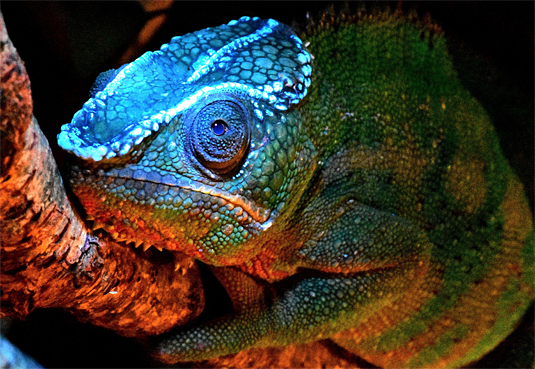Found: Fluorescent Patterns on Chameleons’ Heads
A rare example of biofluorescence that isn’t in the ocean.

Chameleons are pretty impressive creatures—most species can turn almost any color in less than 20 seconds, they can look in two directions at once, and their tongues shoot out so fast that they seem to defy the rules of biology. And the list of chameleonic wonders keeps getting longer. A group of German zoologists recently discovered that some species fluoresce when exposed to ultraviolet light.
Biofluorescence is the ability of an organism to absorb light of one wavelength and then re-emit it at a different one, and is different from bioluminescence, light emitted from a biological chemical reaction. It is usually observed in marine creatures, such as the corals and jellyfish. “So we could hardly believe our eyes when we illuminated the chameleons in our collection with a UV lamp, and almost all species showed blue, previously invisible patterns on the head, some even over the whole body,” said David Prötzel, a doctoral candidate at the Bavarian State Collection of Zoology, in a press release.
Using micro-CT scans, Prötzel and his team, who published their findings in the journal Scientific Reports, found that the fluorescent blue patterns match the distribution of the reptiles’ tubercles, or bony protrusions. The skin over tubercles, they found, it is extremely thin, which allows light to penetrate to the bones, which do the biofluorescing. “It has long been known that bones fluoresce under UV light, but that animals use this phenomenon to fluoresce themselves has surprised us and was previously unknown,” said Frank Glaw, curator of herpetology at the Bavarian State Collection of Zoology.
Researchers believe that the glow helps chameleons communicate their identities to one another. For example, male lizards in most species of the genus Calumma have significantly more fluorescent tubercles than females. That kind of signal must be pretty hard to miss.















Follow us on Twitter to get the latest on the world's hidden wonders.
Like us on Facebook to get the latest on the world's hidden wonders.
Follow us on Twitter Like us on Facebook